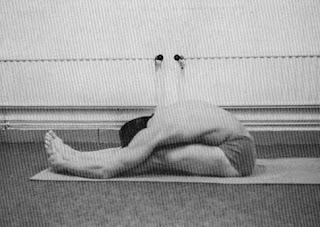Ashtanga Yoga : Jalandhara bandha
Jalandhara bandha
Jalandhara bandha is the water pipe lock. It binds the network of subtle energy channels.
Engaging Jalandhara bandha is useful for alleviating diseases of the throat. It also mproves the quantum of prana in the thoracic region. By pressing the chin to the chest, prana is captured, preventing it from escaping the upper body. Many major nerve fibers pass through the neck; when jalandhara bandha is performed it exerts pressure on them and the flow of nervous impulses to the brain is restricted. These impulses collect in the cervical plexus, and when the bandha is released they flood into the brain. The force of these impulses helps to activate higher centers in the brain, those that function with creativity and intellect.
Practice
Jalandhara bandha
1. Sit comfortably in siddhasana or padmasana (illustration p.13). Place the palms of the hands on the knees and allow the whole body to relax. Inhale slowly and deeply through the nose and retain the breath. Lower the chin so that it touches the collarbone. At the same time, straighten the elbows and raise the shoulders. Hold the breath and the position for as long as comfortable. Then release jalandhara bandha by slowly raising the head and relaxing the shoulders. Exhale in a very slow, controlled manner. Practice five rounds, breathing normally for a few minutes between each round. Then practice five rounds with external retention (exhale and hold).
2. Visualize the throat as a net that captures the breath as it comes up.
3. Notice when the chin is tucked how easy it is to see your navel.
4. Pay attention to the opening of your throat while simultaneously locking the chin.
5. Link all the bandhas and follow the flow of breath unobstructed while maintaining the locks in the body. Notice any change in energy level or effects on your thoughts.
Jalandhara bandha is the water pipe lock. It binds the network of subtle energy channels.
Engaging Jalandhara bandha is useful for alleviating diseases of the throat. It also mproves the quantum of prana in the thoracic region. By pressing the chin to the chest, prana is captured, preventing it from escaping the upper body. Many major nerve fibers pass through the neck; when jalandhara bandha is performed it exerts pressure on them and the flow of nervous impulses to the brain is restricted. These impulses collect in the cervical plexus, and when the bandha is released they flood into the brain. The force of these impulses helps to activate higher centers in the brain, those that function with creativity and intellect.
Practice
Jalandhara bandha
1. Sit comfortably in siddhasana or padmasana (illustration p.13). Place the palms of the hands on the knees and allow the whole body to relax. Inhale slowly and deeply through the nose and retain the breath. Lower the chin so that it touches the collarbone. At the same time, straighten the elbows and raise the shoulders. Hold the breath and the position for as long as comfortable. Then release jalandhara bandha by slowly raising the head and relaxing the shoulders. Exhale in a very slow, controlled manner. Practice five rounds, breathing normally for a few minutes between each round. Then practice five rounds with external retention (exhale and hold).
2. Visualize the throat as a net that captures the breath as it comes up.
3. Notice when the chin is tucked how easy it is to see your navel.
4. Pay attention to the opening of your throat while simultaneously locking the chin.
5. Link all the bandhas and follow the flow of breath unobstructed while maintaining the locks in the body. Notice any change in energy level or effects on your thoughts.



Comments